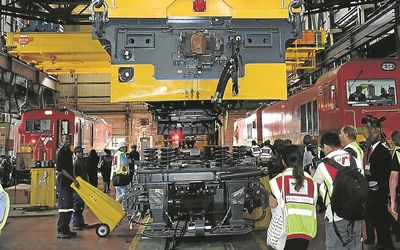THE lack of proper verification for local content, a key requirement for major public sector contracts, has been red-flagged.
Not much monitoring or verification had taken place, Parliament’s trade and industry portfolio committee heard on Wednesday, and public sector companies relied on assurances from contractors.
This raises concerns that, at the end of contract periods, the local content share would be far lower than promised.
Localisation is a key objective of the state to promote industrialisation and economic growth.
Department of Trade and Industry deputy director-general Garth Strachan said at a committee colloquium on localisation that a major obstacle to effective verification had been the failure of the government to resolve the question as to who would pay for it — the state or the procuring entity? The Treasury had to decide on the issue as part of its review of the preferential procurement regime.
"We have to ensure that the cost of verification does not become a huge regulatory hurdle and a disincentive," Strachan said.
Another question was whether only the South African Bureau of Standards (SABS) undertook verifications or whether other agencies should be accredited for this as well. The SABS has been doing verifications but does not get funds from the fiscus for this.
SABS chairman Jeff Molobela said the Preferential Procurement Policy Framework Act was silent on who bore the cost of verification, which was unaffordable for small companies and co-operatives.
Uncertainty over who was to pay for verifications in the contracts between Transnet and locomotive manufacturers had stood in the way of them being done.
There were also no tools to deal with noncompliance of local content obligations, Molobela said.
Between March 2015 and July 2016, the SABS verified 14 companies within designated sectors that had tenders of R2.6bn. Only 4.5% of the total number (286) of tenders worth R57bn in the designated sectors were verified.
Strachan said private sector support for localisation was slow despite commitments made.
"There is very little traction, to be frank," he said. "If government’s 75% target for localisation is to be met, there will need to be a significant scale up on instruments and compliance."
Despite this lack of progress, he highlighted the successes of the automotive industry, clothing and textiles and, more recently, mining in incorporating local suppliers into their supply chain. The procurement of locomotives and trains by the Passenger Rail Agency of SA and Transnet had also resulted in significant localisation.
Strachan stressed that, if localisation was to be accelerated, it would be necessary to speed up the processing of requests for designations. Designations identify particular products which government departments and entities are obliged to procure locally. The Department of Trade and Industry is responsible for regulating designations but the Treasury — which is responsible for government procurement — has to give its approval for designations before they are promulgated.
Another problem, Strachan said, was the lack of compliance with procurement prescripts. Government entities need to build their capacity to build in localisation criteria into tenders for products which are not designated.
A submission by Transnet noted that, so far, 18% (R5.8bn) of the supplier development target (R32.4bn) in the production of 1,064 locomotives had been delivered. Local supplier development represented 69% of the total contract value.
One of challenges in the programme, Transnet said, was to identify suppliers with the required capability to manufacture components which met the specifications of manufacturers.
Bombardier Transportation, China South Rail, China North Rail and General Electric — all of which are contracted to supply locomotives to Transnet — also made submissions.
Strachan highlighted General Electric as an example of a multinational which had decided to use SA as a long-term strategic production hub. It was involved in technology transfer, training and supplier development.

Picture: DEPARTMENT OF COMMUNICATIONS
THE lack of proper verification for local content, a key requirement for major public sector contracts, has been red-flagged.
Not much monitoring or verification had taken place, Parliament’s trade and industry portfolio committee heard on Wednesday, and public sector companies relied on assurances from contractors.
This raises concerns that, at the end of contract periods, the local content share would be far lower than promised.
Localisation is a key objective of the state to promote industrialisation and economic growth.
Department of Trade and Industry deputy director-general Garth Strachan said at a committee colloquium on localisation that a major obstacle to effective verification had been the failure of the government to resolve the question as to who would pay for it — the state or the procuring entity? The Treasury had to decide on the issue as part of its review of the preferential procurement regime.
"We have to ensure that the cost of verification does not become a huge regulatory hurdle and a disincentive," Strachan said.
Another question was whether only the South African Bureau of Standards (SABS) undertook verifications or whether other agencies should be accredited for this as well. The SABS has been doing verifications but does not get funds from the fiscus for this.
SABS chairman Jeff Molobela said the Preferential Procurement Policy Framework Act was silent on who bore the cost of verification, which was unaffordable for small companies and co-operatives.
Uncertainty over who was to pay for verifications in the contracts between Transnet and locomotive manufacturers had stood in the way of them being done.
There were also no tools to deal with noncompliance of local content obligations, Molobela said.
Between March 2015 and July 2016, the SABS verified 14 companies within designated sectors that had tenders of R2.6bn. Only 4.5% of the total number (286) of tenders worth R57bn in the designated sectors were verified.
Strachan said private sector support for localisation was slow despite commitments made.
"There is very little traction, to be frank," he said. "If government’s 75% target for localisation is to be met, there will need to be a significant scale up on instruments and compliance."
Despite this lack of progress, he highlighted the successes of the automotive industry, clothing and textiles and, more recently, mining in incorporating local suppliers into their supply chain. The procurement of locomotives and trains by the Passenger Rail Agency of SA and Transnet had also resulted in significant localisation.
Strachan stressed that, if localisation was to be accelerated, it would be necessary to speed up the processing of requests for designations. Designations identify particular products which government departments and entities are obliged to procure locally. The Department of Trade and Industry is responsible for regulating designations but the Treasury — which is responsible for government procurement — has to give its approval for designations before they are promulgated.
Another problem, Strachan said, was the lack of compliance with procurement prescripts. Government entities need to build their capacity to build in localisation criteria into tenders for products which are not designated.
A submission by Transnet noted that, so far, 18% (R5.8bn) of the supplier development target (R32.4bn) in the production of 1,064 locomotives had been delivered. Local supplier development represented 69% of the total contract value.
One of challenges in the programme, Transnet said, was to identify suppliers with the required capability to manufacture components which met the specifications of manufacturers.
Bombardier Transportation, China South Rail, China North Rail and General Electric — all of which are contracted to supply locomotives to Transnet — also made submissions.
Strachan highlighted General Electric as an example of a multinational which had decided to use SA as a long-term strategic production hub. It was involved in technology transfer, training and supplier development.




















